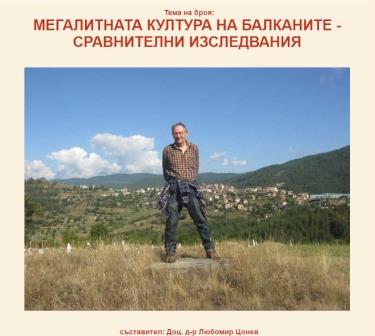АНТИЧНИЯТ АНСАМБЪЛ СТЪЛПИЩЕ, РУСЕНСКО – ЕЛЕМЕНТ ОТ ТРАКО-ФРИГИЙСКАТА КОНТАКТНА ЗОНА
THE ANCIENT ENSEMBLE “STALPISHTE”, REGION OF ROUSSE – A COMPONENT OF THE THRACIAN-PHRYGIAN CONTACT ZONE
Author(s): Lyubomir TsonevSubject(s): History, Anthropology, Social Sciences, Archaeology, Cultural history, Sociology, Comparative history, Ethnohistory, Local History / Microhistory, Social history, Ancient World, Prehistory
Published by: Асоциация за антропология, етнология и фолклористика ОНГЬЛ
Keywords: megalithic monuments; Bulgaria; menhirs; Balkan Peninsula; prehistory;
Summary/Abstract: The locality Stalpishte / Dikili-tash (Russe) presents a combination of natural and historical objects which have a noticeable cultural and touristic potential. The present study collects all the data concerning the historical monuments from the Late Antiquity and the early Middle Ages including photographs and original descriptions. An interpretative analysis is proposed of two monuments in the locality Stalpishte / Dikili-tash: (1) a rock reflief of a horseman and (2) a cave sanctuary crowned with a rock-graved pediment. The figure of the horseman has a Thracian origin, but its rock-cut representations have been spread over the whole Thracian-Phrygian region in Roman times. The Thracian horseman is depicted on the reliefs in various compositions (the hunter-god Heros, the war-god Ares, the local king possessing a god-dignity etc.) but always in the frames of the thracian mythology infiltrated into Phrygia. The cave sanctuary with a rock-cut pediment is a more complicated object. Rock temples and graves are created in Thracia as well as in Phrygia. Pediments are also widely used in both regions. Pediments graved over rock (or cave) temples or over rock facades are a typically Phrygian phenomenon. In this sense the rock sanctuary in Stalpishte / Dikili-tash is unique on the Balkan peninsula, i.e. for the Thracian area, and it has been built possibly in Roman times under the influence of the Phrygian architecture. However, the pediment over the cave sanctuary in Stalpishte / Dikili-tash contains a typical Thracian element – four graved trapezoidal niches which are known in the East Rhodope Mountain (i.e. in Thrace) only. We can conclude that the monuments in Stalpishte / Dikili-tash (Russe) demonstrate in an very impressing and convincing way the cultural interactions between Thracia and Phrygia in Roman times.
Journal: Електронно списание »Онгъл«
- Issue Year: 2017
- Issue No: 14
- Page Range: 165-201
- Page Count: 37
- Language: Bulgarian

